Xinjiang, the autonomous region of China, is bordering with Central Asia. Almost 47 ethnic groups live in Xinjiang, including Han Chinese, and they have a great historical background about culture and heritage. All the ethnic groups represent their own culture and tradition, but the Uyghur's have the most beautiful, epic culture and heritage.
Xinjiang People; Xinjiang Population:
According to the census data released by the Bureau of statistics of Xinjiang Uyghur Autonomous Prefecture, the total population of Xinjiang is 22.9847 million, of which ethnic minorities account for 63%. At present, there are 14 prefectures, autonomous prefectures, counties, and cities, plus Xinjiang Production and Construction Corps is an integral part of the autonomous region. It has 14 divisions and 176 farms for farming and animal husbandry, with a total population of about 2.7 million.
At the end of 2017, the permanent population of Xinjiang Uyghur Autonomous Region was 24.4467 million, an increase of 46,5900 over the end of last year, including 12.0718 million urban permanent residents, accounting for 49.38% of the total population (urbanization rate of permanent residents), an increase of 1.03 percentage points over the end of last year. The annual birth rate is 15.88%, the mortality rate is 4.48 %, and the natural growth rate is 11.40%
Distribution of Xinjiang Ethnic Minorities:
There are 47 ethnic nationalities in Xinjiang, mainly Uyghur, Kazakh, Han, Hui, Mongolian, Kirgiz, Xibo, Tajik, Uzbek, Manchu, Daur, Tatar, and Chinese Russian.
Uyghur
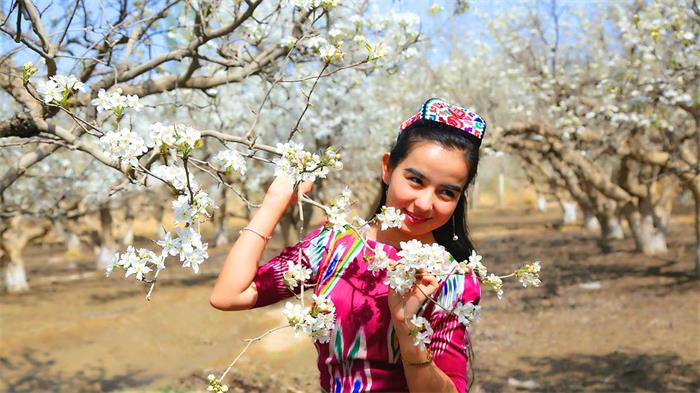
The Uyghur nationality has a population of over 8 million, the majority of them live in compacted communities of the areas to the south of Tianshan Mountains, such as Kashgar, Hotan and Aksu, and the rest inhabited in Ili prefecture and other places in the northern part of Xinjiang.
Uyghur traditional dance is considered as the most beautiful and famous dance in Xinjiang. Every year Uyghur arranges the different programs in the Xinjiang International Grand Bazaar in Urumqi, where the Uyghur artists perform their culture. During the performance, the Uyghur artists use to wear a unique cultural dress and cap, and some people sing classical songs. The Uyghur's most of the customs and traditions stem out from Islam. However, Uyghur's are different from many Muslims in that they love to dance and music, and the women perform publicly.
Kazakh:
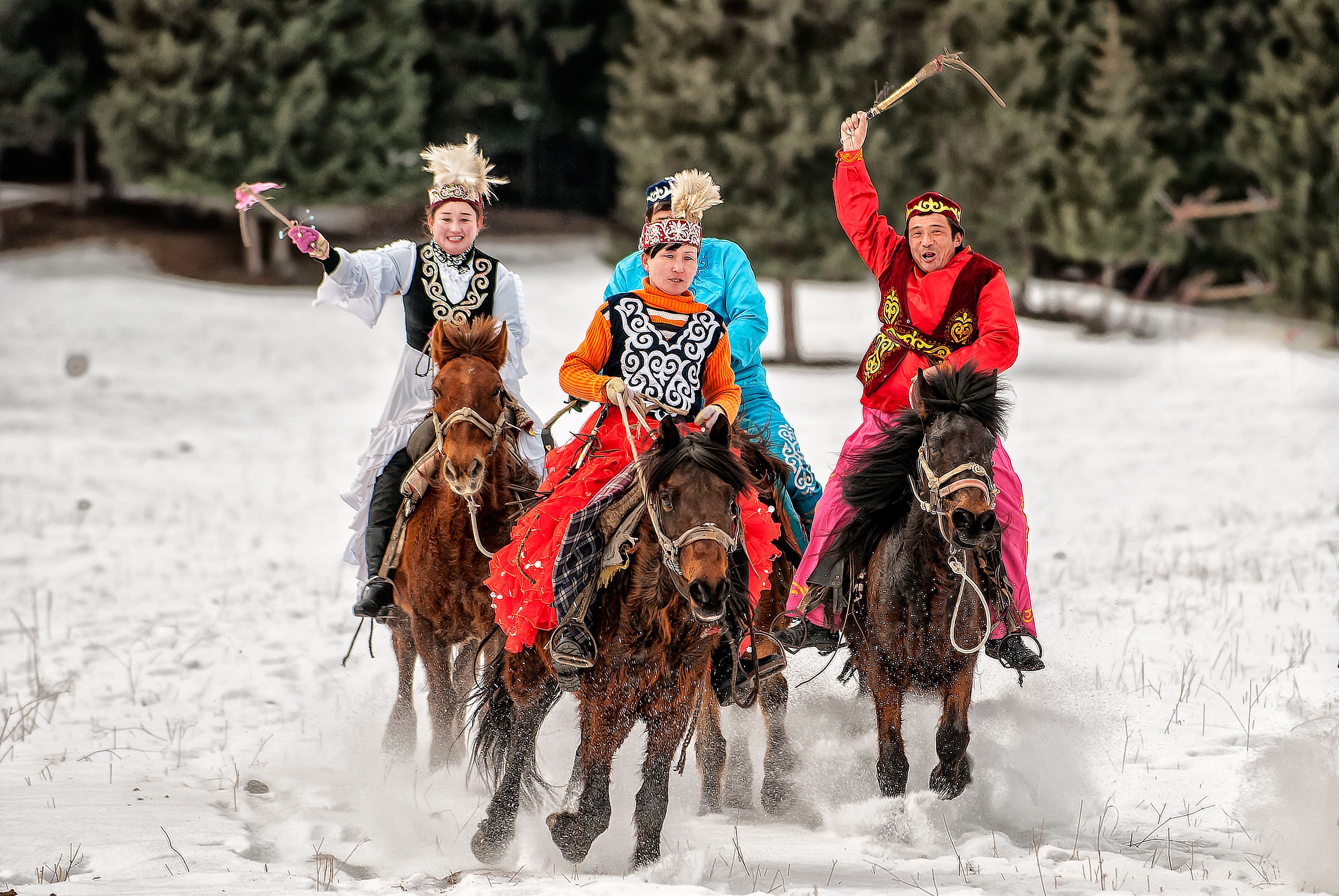
Named "A Nationality on Horseback," Kazakh in Xinjiang has a population of over 1.2 million, with the majority living in the Ili Kazak Autonomous Prefecture, Mori Kazakh Autonomous County and Barkol Kazakh Autonomous County. Kazak language is a member of the Turkic Language Group of the Altaic Language Family and is classified into two dialects: the southwestern and northeastern dialects.
In spring, summer, and autumn, they live in collapsible round yurts and winter in flat rooted earthy or wood houses in pastures. Meanwhile, Kazakh villager will celebrate the Nowruz festival at the beginning of the New Year; on this day; they use to perform a special dance with a particular dress.
Kazakh's arts have a great variety, including crafts, music, and dance. In terms of works, there are sculptures, embroidery, and picture design. The two-stringed instrument, "Dongbula", is their favorite.
Kirgiz:
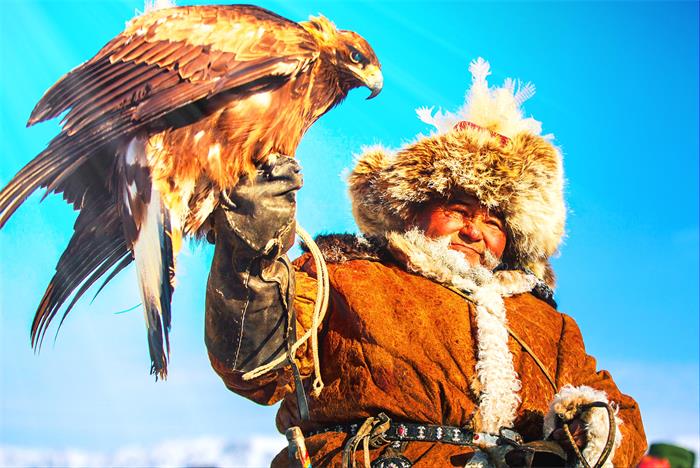 Kirgiz
Kirgiz
With a population of 254000, most of the Kirgiz are inhabitants in the Kizilsu Kirgiz Autonomous Prefecture in the southwestern part of the Xinjiang. The yurts are the primary dwellings of Kirgiz herders, made of felts, called "Boziwu" The settled Kirgiz mostly lives in flat-roofed square mud houses.
At the beginning of the first month of the year (20/21 March, the Gregorian Calendar ), the Kirgiz celebrate their traditional festival, "Nawurez" Apart from this festival, they also celebrate the Islamic festivals, such as Fast-breaking or Eid-ul-Fitr and the Corban Festivals.
Mongolian:
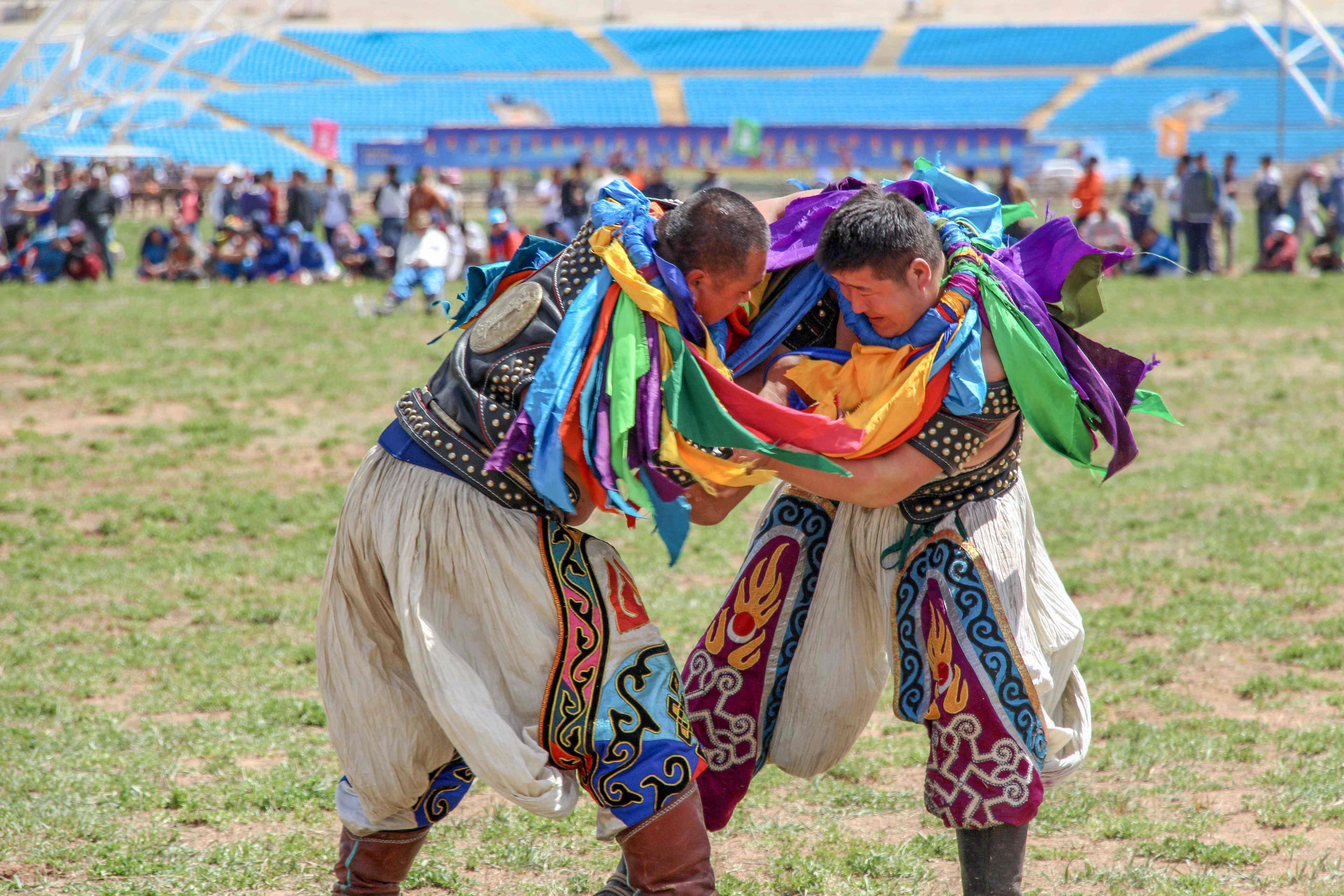
With a population of 180,000, most of the Mongolians in Xinjiang live in Bayinguoleng and Bortala Mongolian Autonomous Prefectures and Hebukeser Mongolian Autonomous County.
Jiangger, an epic of the Oirat Mongolians, is one of the three famous epics in China. The Mongolians have been known as "a people of music and poetry." Horsehead fiddle is a musical instrument favored by the Mongolians. Additionally, they also have two strings violin Tuoburshu in Xinjiang.
Hui: With a population of 730,000, the Hui mainly live in the area of Changji Hui Autonomous Prefecture, Miquan, Yining City, Huocheng City, Urumqi, Yanji Hui Autonomous County, and Turpan region. Because living with Han and other minorities for quite a long time, their habits, language, and costumes are almost the same style as the local people.
Tajik:
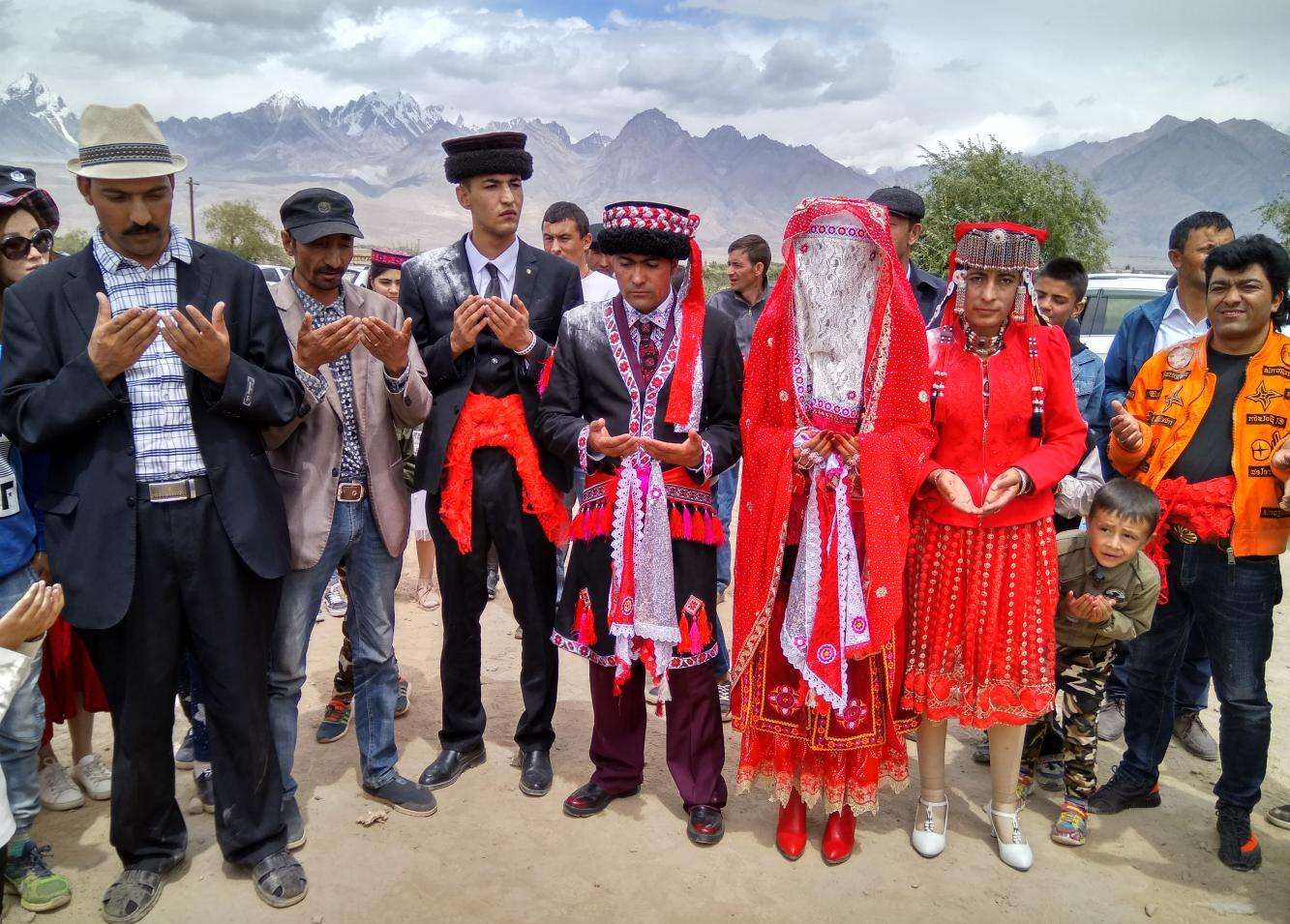
Herdsmen of the Tajik ethnic group catch sheep in an event steeped in tradition to welcome spring in the Tashi Kuergan, Tajik autonomous region in Xinjiang. However, as the only ethnic group in China with Europa origin. Tajik people are one of the 56 official ethnic groups in China that primarily reside in Xinjiang. Most of them are living in Tashkurgan ( The county near Tajikistan, Pakistan, and Afghanistan). Their nomadic population of about 40,000 is majority Muslim. Most Tajiks in Xinjiang speak the Sarikoli language.
Daur People: Daurs form an ethnic nationality with long-standing agricultural culture and a long history in north China. In the Qing Dynasty, Daurs were organized in the "Eight Banner System" and transferred to the frontier regularly, even as far as to Xinjiang. About 5 thousand of them are found in the Tacheng area, and some of them in Huocheng county and Urumqi. They are descendants of Daur soldiers who moved Tacheng in the time of the Qing Dynasty.
Xibo: In the Mid-18 century, the Qing court-ordered them from northeastern China to Xinjiang to consolidate and reinforce the northwestern border defenses. These Xibo settled down in the Ili River Valley and made this area as their second hometown. With a population of 36,000 in Xinjiang, most of Xibe live in Qapal Xibe Autonomous county, Huocheng County and Gongliu County.
Tatar: In the 1920s to 1930s, Tatar in Xinjiang moved from Central Asia and Russia. With a population of more than 5,000, they live in Yining, Tacheng, Urumqi snd other towns in southern Xinjiang.
Manchu: With a population of over18,000 in Xinjiang, Manchu people scatter in the vast land but mainly live in Ili, Changji, and Urumqi. The majority of them are descendants of garrisoned "eight banners" battalions. The Qing Court transferred Manchu soldiers. Some immigrated from inland provinces.
Uzbek: With a population of more than 12,000, Uzbek live in scattering way over a wide area of the Xinjiang Uygur Autonomous Region. Most of them are city dwellers; some live in the pastoral and the rural regions.
The Chinese Russians: With a population of 8500, the Chinese Russians in Xinjiang live in Ili, Tacheng, Alati, and Urumqi.
Tuva People in Xinjiang
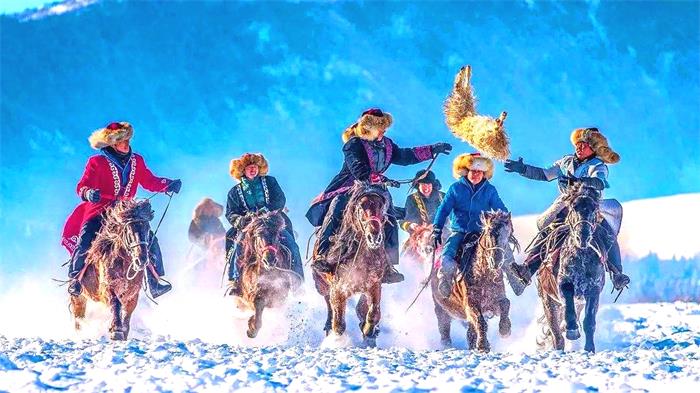
At the foot of the Altai Mountains, there are group-Tuva people. With a population of about 2,500, most of them live in Baihaba Village, Hemu Tuva Village in Burqin County, and Kanas village. Tuva people have their language but do not have a writing system. Therefore, there is no Tuva ethnography nor history books and even any written records about their past and life. Tuva language used by Tuva people is one of the rare expressions in China, which distinguishes words of the Mongolian group of Altaic Language Family and belongs to the Turkic language group. Many Tuuva people can speak the Kazakh language. The Tuva people build their houses with pinewood with fences around the house, which is quite different from Mongolian tribes in the pasture. Their favorite drink is milk wine instead of horse milk wine the Mangolans favor.
Some scholars hold the view that Tuva people are off-spring of the aged, weak, sick, and disabled soldiers left by Genghis-khan when he led his troops to attack the Western Regions. But Tuva elders said their ancestors migrated from Siberia 500 years ago and are the same ethnic group as the Tuva people of the Tuva Republic of Russia. They make a living by hunting, fishery, and a small portion of primitive farming. They are very sincere, and hospitable Tuva people believe in Buddhism. Integrating, they constitute the unique view and folk at Kanas and are termed"a tribe in the picture"because of Kanas's beauty.
Recommended Xinjiang Tours:
12 Days Xinjiang Private Tour: Kanas Lake and Kashgar
12 Days Xinjiang Travel to Kanas Lake and Taklamakan Desert Kuqa
7 Days Classic Xinjiang Tour to Kashgar, Turpan and Urumqi




































